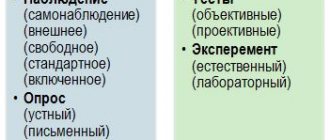Psychological diagnostics (psychodiagnostics) is the science of methods for measuring, classifying and ranking the psychological and psychophysiological characteristics of people, as well as the use of these methods for practical purposes. Psychological diagnostics is an applied branch of psychology, the main purpose of which is the purposeful and detailed study of the personality in all the diversity of its individual mental manifestations in various life situations and operating conditions.
Psychodiagnostics is based on knowledge of the laws of general, differential and experimental psychology, the nature and structure of the psychological phenomena being studied, as well as knowledge of the laws of the psychological research process, including the characteristics of psychodiagnostic tools, socio-communicative and ethical aspects of the interaction between the psychologist and the subject.
Standardized and qualitative methods
The first division of psychodiagnostic methods that we will talk about concerns the content part. Based on it, psychodiagnostic methods are divided into:
- Standardized methods
- Clinical methods
Standardized psychodiagnostic methods are considered the most effective if it is necessary to obtain data on a group of people in a short time, and also to make any specific decision based on a quantitative justification of reliability. Standardized methods are protected from various types of errors that may arise due to the low qualifications of the specialist implementing the methods.
Qualitative methods of psychodiagnostics are more effective if they are used by experienced psychologists, for example, specialists in personnel recruitment or professional selection, etc. Through qualitative methods, it is possible to study the personal characteristics of people with greater accuracy and depth, but they require a significantly larger amount of time for their implementation. Among other things, professional psychodiagnosticians agree that qualitative methods can be even more effective if a psychologist conducts psychological training, psychotherapy or psychological correction with a person, based on the results of using the method.
Low-formalized and highly formalized methods
In psychodiagnostics, methods are also distinguished based on how formalized they are. Thus, two groups of methods are distinguished:
- Less formalized methods
- Highly formalized methods
The group of less formalized methods includes those that realize the potential of general methods of psychological diagnostics of a person. Among them are analysis of performance results, diagnostic conversation, observation, etc. The use of such methods requires a highly qualified specialist, because in most cases, these methods lack standards for implementation and interpretation of results.
Among highly formalized methods, various forms of testing and surveys are distinguished. They are distinguished by many characteristics, for example, strict regulations for conducting, processing and interpreting results, a high degree of reliability, etc. For this reason, the diagnostic procedure is structured so that none of the subjects has any advantages over the others.
Test and survey methods
The two types of methods we consider below belong to highly formalized methods. The most popular among them are test methods, the main one of which is testing, which involves solving standardized tasks, the purpose of which is to determine quantitative (in some cases, qualitative) characteristics that describe the psychological characteristics of an individual according to given parameters. In terms of content, test methods are divided into a number of groups:
- Personality tests
- Achievement tests
- Aptitude tests
- Intelligence tests
With the help of such tests, it becomes possible to give an objective assessment of the level of development of a person’s personal characteristics, which can be attributed to mental processes and formations.
Survey methods are used in psychodiagnostics to determine the level of development of a person’s mental properties. These techniques take the form of surveys aimed at studying the psychological characteristics of the subjects’ personal sphere. The assessment is given after interpreting the answers that the test takers give to the questions posed (as a rule, several answer options are offered).
In practice, among psychodiagnostic specialists, it is common to use methods that include both test and survey tasks. Such methods are called test-survey.
Introduction
Diagnostics is the theory and practice of making a diagnosis. This term has at least two meanings:
— by diagnosis it seems possible to mean determining the essence, the cause of any problem in order to eliminate it. With the help of diagnosis, certain decisions are directly made.
- diagnosis can be understood as a comprehensive, holistic examination of an object, with the goal of assessing its general condition. Obtaining such an assessment may be necessary for various purposes (for example, preventive).
Usually, with the help of such diagnostics, certain weaknesses are identified that need to be strengthened.
It should be noted that the person making the diagnosis (diagnostician) does not have the desire to establish and describe general patterns; its task is to provide concrete assistance in eliminating existing problems.
In addition, it is necessary to pay attention to the fact that in the process of revealing the concept of “diagnosis”: this in any case is the subsuming of a specific case under a certain phenomenon, which is broad in nature. The main goal of the diagnostician is to discern the general and typical in the particular.
It should be noted that psychological and pedagogical diagnostics has its own range of methods. Methods of psychological and pedagogical diagnostics are methods of studying personality.
An essential feature of diagnosis is its focus on the norm. The norm is the quantitative boundaries within which the most typical part of the examined group is located. Statistical norms in relation to personality are determined by narrow specialists (sociologists, physiologists, psychologists).
Statistics strengthen the evidence obtained by comparison with the norm and show the likelihood of the symptom occurring. The teacher's task is much simpler. Being a practitioner, he does not independently determine these norms through the use of ready-made data. It is sufficient to identify the trait, ensure its representation and establish the qualitative level of its development.
2 pages, 695 words
Diagnostics of musical abilities of children
Among them, seven were tested. The children were curious about the tasks and completed them with great interest. Victoria Viktorovna Svetlova (Born on April 12, 1996 in a complete family) is a thoughtful, well-rounded girl with good academic performance. He catches on quickly. He loves music very much and goes to music school. Good plasticity - she practices oriental dances. Shows initiative and goes first...
The purpose of writing the work is to consider the theoretical aspects of the concept and the specifics of methods of psychological and pedagogical diagnostics.
Methods by form of implementation
Methods of psychodiagnostics can also differ in the form of implementation - they can be individual, group, form (written), oral, machine (hardware), computer, as well as verbal and non-verbal. At the same time, they all consist of several components, namely:
- Operation Guides
- Stimulus (test) material
- Answer registration sheet
- Key for processing responses
- Interpretive material for interpreting the results
If one person undergoes a psychodiagnostic procedure, it is called individual , and if there are several people, then it is called group . Both the individual and group methods have their pros and cons.
For example, group methods make it possible to study the characteristics of a large number of people, have more uniform implementation conditions, and also simplify the work of a specialist and require less time to obtain results. However, the disadvantages include the reduced ability to establish contact and understanding with the subjects and the formation of positive motivation in them regarding diagnosing the sphere of their personality. At the same time, individual methods do not have such disadvantages, but they only allow you to work with individual people.
Almost all methods of psychodiagnostics that are used in our time are written (form) , i.e. have the form of written tasks, to complete which it is enough to provide the people being studied with answer sheets and writing materials. But oral methods continue to be used today, albeit somewhat less frequently. In the process of conducting oral psychodiagnosis, the researcher asks questions, and the subject answers them.
Machine (hardware) methods of psychodiagnostics involve the use of special technical means (special machines and other diagnostic equipment) that operate on a mechanical principle to record responses and interpret data. If a computer method is used, for example, a computer survey or testing, then the processing of the received information is greatly simplified, as is their interpretation, because all data is in the form of tables, diagrams, diagrams, graphs, etc.
It is also important to note that computer psychodiagnostics allows you to analyze the data obtained in the shortest possible time, which would be impossible if other methods were used, because they require considerable time. For this reason, specialists have the opportunity to diagnose at a deep level the individual characteristics of people’s thinking, determine the tempo and other characteristics of their activity.
In the case of using verbal methods of psychodiagnostics, the researcher and the subject interact in a verbalized (verbal-logical) form. When nonverbal methods are used, the stimulus (test) material takes the form of graphic images, drawings, pictures, etc.
Literature
1. Burlachuk L.F. Psychodiagnostics: textbook/ L.F. Burlachuk. -2nd ed., revised. and additional -M.: Peter, 2009
2. Borytko N.M. Diagnostic activity of a teacher: textbook. manual edited by V. A. Slastenina, I. A. Kolesnikova. -2nd ed., erased. . -M.: Academy, 2008
3. Psychological diagnostics: textbook: rec. UMO / ed. M.K. Akimova, K.M. Gurevich. -3rd ed., revised. and additional.. -SPb.: Peter, 2008
4. Psychological and pedagogical diagnostics: educational method. complex for special 050711 -Social pedagogy/ AmSU, FSN; comp. S. S. Stepanova. -Blagoveshchensk: Amur Publishing House. state University, 2009
5. Practical psychodiagnostics: methods and tests / ed., comp. D. Ya. Raigorodsky. -Samara: BAKHRAH - M, 2012
6. Ratanova T.A. Diagnostics of mental abilities of children: textbook. - method. allowance / T. A. Ratanova. -3rd ed., rev. . -M.: Moscow. psychol.-social Institute, 2012
11 pages, 5175 words
Psychological and pedagogical diagnostics based on information and communication tools…
... theoretically study the problem of psychological and pedagogical diagnostics based on the means ... psychodiagnostics of developmental disorders is very large: timely identification of children with developmental disorders is required; determination of their optimal pedagogical... and pedagogical diagnostics. .Consider the classification of computer diagnostic techniques. In... in studies; professional consulting and...
11
Examples of similar educational works
Section 2. Features of the use of psychological and pedagogical research diagnostics...
... psychological and pedagogical diagnostics, research into the levels of development of artistic and creative activity of children ... the student is based on personal observations, but does not have a developed ... allow the drawing to recreate the process of arrangement in the working field ...
PSYCHOLOGICAL AND PEDAGOGICAL DIAGNOSTICS OF OLDER CHILDREN’S COMMUNICATIVE ACTIVITY...
... the process of interaction between individuals. He further emphasizes that communication is necessary to establish interaction that is beneficial for the process of activity. ... priority implementation of activities for the artistic and aesthetic development of children"" of the city...
Psychological and pedagogical diagnostics based on information and communication tools…
... aimed at solving problems of optimizing the educational process, then the tasks it faces are diverse. The main tasks of psychological and pedagogical diagnostics: - determine the levels of child development; -detect changes in basic characteristics and...
Psychological and pedagogical diagnostics of spiritual and moral education and development...
... to determine the essence of the concept of psychological and pedagogical diagnostics, spiritual and moral education, spiritual and moral development. — to identify the relationship between moral education and the general pedagogical process; - find research aimed...
Psychological and pedagogical diagnostics 5
... diagnostics allows you to make long-term and short-term development forecasts, and therefore allows you to improve the processes of goal setting and activity planning ... “by eye” - as a result of pedagogical observation. But for him, and even more so...









